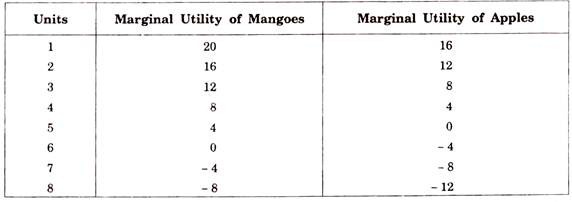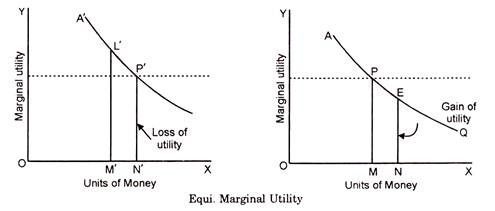The below mentioned article provides a beginners’ guide to the law of equi-marginal utility.
This article will help you to understand the following things:- 1. Introduction to the Law of Equi-Marginal Utility 2. Definition of the Law of Equi-Marginal Utility 3. Assumptions 4. Explanation 5. Diagrammatic Representation 6. Importance 7. Modern Interpretation of the Law.
Introduction to the Law of Equi-Marginal Utility:
All human activities are directly connected towards satisfaction of human wants.
The consumer wants to get maximum satisfaction of his wants. The wants are unlimited and the means to satisfy them are limited.
ADVERTISEMENTS:
Thus, the limited means are used in such a manner that the consumer gets maximum satisfaction.
To explain this point, the law of Equi-marginal Utility has been given by Marshall. This law is one of the basic principles of Economics. It is also known as the Law of Substitution and the Law of Maximum Satisfaction. This concept is also known as “The Second Law of Gossen”.
Definition of the Law of Equi-Marginal Utility:
According to Prof. Hicks – “Utility can be maximum only when equal utility is received from the marginal unit of expenses in all the cases.”
Regarding this Prof. Marshall has said that – “If a person has a thing which he can put to several uses he will distribute it among these uses in such a way that it has the same marginal utility in all.”
ADVERTISEMENTS:
If it has a great marginal utility, in one use than in another, he would gain by taking some of it from the second use and applying it to first. He has further stated that the total utility to be maximum a given income must be so divided between different articles of consumption, so as to yield equal marginal satisfaction along each line of expenditure.
In this way the consumer makes a scale of preference of using his limited income to the consumption of various commodity. He spends on the consumption of different commodity when the marginal utility is equal and at this point the total utility is maximum and he will get maximum satisfaction at this point.
Assumptions of the Law of Equi-Marginal Utility:
The important assumptions of this law are as follows:
(1) Consumer is a rational being, it means he wants to get maximum satisfaction with the limited means which he has got, and therefore, he spends his money very cautiously and after examining all Pros and Cons of his expenditure.
ADVERTISEMENTS:
(2) It has been considered essential to measure the utility in terms of money.
(3) There must be perfect competition in the market.
(4) Goods must be divided as per need and requirement.
(5) Marginal utility of money must be stable.
(6) There need not be any change in the income, taste, fashion etc. in the make this law applicable.
(7) Consumer should spend his income gradually and in small quantity.
(8) Price of the goods should be stable and the consumer should know available.
Explanation of the Law of Equi-Marginal Utility:
In order to get the maximum satisfaction out of the funds which the man has, he carefully weigh the satisfaction which he derives from each rupee which he has spend. If he finds that a rupee spend on any one item has greater utility than the other he prefers to spend on the former item till the utilities derived from the last rupee spent in the two cases are equal.
In other-words, he substitutes some units of a commodity of greater utility for some units of less utility. The result of this satisfaction will be that the marginal utility of the former will fall and that of the latter will rise till the two marginal utilities are equalised. Thus, the law is called the Law of Substitution or the Law of Equimarginal Utility.
ADVERTISEMENTS:
This can be explained by the following table:
Let us suppose that there are two commodities apples and mangoes which are to be purchased and have fourteen rupees to spend on this purchase. We have spend six rupees on mangoes and eight rupees on apples. What is the result? The utility of the 3rd unit of mangoes is 12 and that of 4th unit of apples is 4.
In this table, the marginal utility of mangoes is higher we would purchase more of mangoes and less of apples. Further, let us substitute one mango for one apple, so that we purchase eight mangoes and six apples. Now, the marginal utility of both i.e., mangoes and apples is the same i.e., 8. This arrangement will yield maximum satisfaction.
ADVERTISEMENTS:
The total utility of 8 mangoes would be 20 + 16 + 12 + 8 = 56 and six apples 16 + 12 + 8 = 36 which gives us a total utility of 56 + 36 = 92. The satisfaction given by 8 mangoes and 6 applies at one rupee each is greater than could be obtained by any other combination of apples and mangoes. In no other case does this utility will be 92.
From this example the conclusion can be drawn will be that we can obtain maximum satisfaction when we equalize marginal utilities by substituting the more useful for the less useful commodity, this can be shown with the help of a diagram as follows:
Diagrammatic Representation of the Law of Equi-Marginal Utility:
In the two figures given below, OX and OY are the two axis. On X-axis OX measures money and on Y-axis marginal utilities. Suppose, a person has 14 rupees to spend an apples and mangoes whose diminishing marginal utilities are shown by the two curves AQ and OS respectively.
The consumer will gain maximum satisfaction if he spends OM money (i.e., rupees six) on apples and OM’ money (8 rupees) on mangoes because here the marginal utilities of the two are equal i.e., (PM = P’M’). Any other way of measurement may give less total satisfaction.
ADVERTISEMENTS:
In this example the purchase spends MN money (one rupee) more on apples and the same amount of money; N ‘M’ (= MN) less on oranges. The diagram shows a loss of utility represented by the shaded are LN’M’F and a gain of PMNE utility.
As MN = N’M’ and PM = P ‘M’, it is proved that the figure LN ‘M’ P’ (loss of utility from reduced consumption or mangoes) is bigger than PMNE (gain of utility from increased consumption of apples). So, the total utility of this new-combination is less.
In the end it can be said that no other combinations of apples and mangoes gives as great, a satisfaction to the consumer as when PM = P ‘M’, i.e., where the marginal utilities of apples and mangoes purchased are equal, with given resources which can be obtained at our command.
Practical Importance of the Law of Equi-Marginal Utility or Application of This Law in Different Fields:
In Economics the law of Equi-Marginal Utility has got wide-importance. It will not be improper to say that it is “Backbone of Economics”. This law is applicable in all the fields of Economics therefore it has been called as “Universal Law”. Regarding this Law Prof. Marshall has said—“The application of the principle of substitution extends over almost every field of economic enquiry.”
This law is used in different fields of economics as follows:
1. Importance in the Field of Consumption:
ADVERTISEMENTS:
It has been seen that a wise consumer always try to follow this law while he is arranging to incur expenditure. His expenditure is so distributed that the same price measures equal utilities at the margin of different purchases and different expenses.
It is human nature that every man tries to spend his income in such a way which yields him the greatest satisfaction. This he will be able to do, if he spends his money in such a manner as to obtain equal satisfaction from the marginal units of money spent on the various commodities he purchases.
2. Importance in the Field of Production:
The name of this law in the field of production is “Law of Equimarginal Return”. This law is of great importance in the field of production. In production producer wants maximum of ‘Net Profit’. Therefore he should substitute one factor for another, so as to have the most economical expense. For this purpose, he will substitute labour for machinery and machinery for labour, so that the marginal utility or marginal productivity of the two is equalised in this way and he will get the most economical combination of production.
3. Importance in the Field of Exchange:
By exchange we mean substitute of one thing for another. This law is also applicable in exchange when we sell a commodity say, rice, we get money. With the help of this money we can buy another commodity say, wheat. In this way we can substitute rice for wheat.
4. Importance in the Field of Distribution:
In the field of distribution the principle of marginal productivity applies. And as per the principle of marginal productivity the share of each factor of production i.e., land, labour, capital and organisation is determined and applied in the completion of the activities.
Here, the use of each factor is pushed up to a point where its marginal product is equal to the marginal product of every other factor. This is the activity of substituting one factor for the other and in distribution the various factors of activities are taken together.
5. Importance in the Field of Public Finance:
ADVERTISEMENTS:
This law is helpful in guiding the government when the activities of public expenditure is taken up. As per the law the Government must cut down all wasteful expenditure. Where the return is not proportionate and proper.
He should therefore, concentrate its resources on more productive, suitable and more beneficial expenditure. Further, the public revenue is spent on such heads, so that the government may secure maximum welfare for the community.
6. Helpful in Influencing Prices:
This law of substitution influences prices in the market. When the price of a commodity goes up it becomes scarce in the market then in that case we substitute for the thing, some other things which are less scarce. The price of the commodity automatically comes down.
Modern Interpretation of the Law, Law of Proportionality:
Modern economists have discussed the Law of Equi-marginal Utility in a different and new way. The new methods and systems have been given the name—”Law of Proportionality”. Their view is that we can get maximum satisfaction from a commodity only when there is perfect co-relation and co-ordination between the price of each commodity and its Marginal Utility.
This can be shown in the following manner:
If there is rise in the price of the commodity A people will start the use of commodity B and if there is rise in the price of B people will start the use of commodity C and in the end such a situation will come where the demand and supply will be in proportion of all the three goods and will be equal and here the situation of maximum satisfaction will come up. Because of this approach and opinion of the modern economists there will be no need to measure the utility of each unit of the commodity.
ADVERTISEMENTS:
Our interest will be to keep the price of the commodity and its marginal utility in the same proportion. But regarding this law one important thing to note is that we cannot measure the profit and loss derive from the Law of Substitution. So the above equation will hold good, if the consumer’s tastes and other circumstances remain unchanged and the commodities are perfectly divisible.


